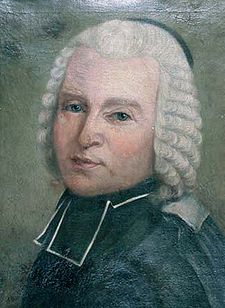- Nicolas Louis de Lacaille
-
Nicolas Louis de Lacaille 
Portrait of Nicolas Louis de LacailleBorn March 15, 1713
Rumigny, ArdennesDied March 21, 1762 (aged 49) Citizenship French Fields astronomy Abbé Nicolas Louis de Lacaille (March 15, 1713 – March 21, 1762) was a French astronomer.
He is noted for his catalogue of nearly 10,000 southern stars, including 42 nebulous objects. This catalogue, called Coelum Australe Stelliferum, was published posthumously in 1763. It introduced 14 new constellations which have since become standard.[1] He also calculated a table of eclipses for 1800 years.
In honor of his contribution to the study of the southern hemisphere sky, a 60-cm telescope at Reunion Island will be named the La Caille Telescope.
Contents
Biography
Born at Rumigny, Ardennes, he was left destitute by the death of his father, who held a post in the household of the duchess of Vendôme. Therefore, his theological studies at the College de Lisieux in Paris were undertaken at the expense of the duke of Bourbon.
After he had taken deacon's orders, however, he concentrated on science, and, through the patronage of Jacques Cassini, obtained employment, first in surveying the coast from Nantes to Bayonne, then, in 1739, in remeasuring the French arc of the meridian, for which he is honored with a pyramid at Juvisy-sur-Orge. The success of this difficult operation, which occupied two years, and achieved the correction of the anomalous result published by J. Cassini in 1718, was mainly due to Lacaille's industry and skill. He was rewarded by admission to the Academy and the appointment of mathematical professor in Mazarin college, where he worked in a small observatory fitted for his use.
His desire to observe the southern heavens led him to propose, in 1750, an astronomical expedition to the Cape of Good Hope. This was officially sanctioned by Roland-Michel Barrin de La Galissonière. Among its results were determinations of the lunar and of the solar parallax (Mars serving as an intermediary), the first measurement of a South African arc of the meridian, and the observation of 10,000 southern stars. On his return to Paris in 1754 Lacaille was distressed to find himself an object of public attention; he withdrew to Mazarin college, where he worked actively for some years, and there died of an attack of gout aggravated by over-work in 1762.
Lalande said of him that, during a comparatively short life, he had made more observations and calculations than all the astronomers of his time put together. The quality of his work rivalled its quantity, while the disinterestedness and rectitude of his moral character earned him universal respect.
In 1754, de Lacaille was elected a foreign member of the Royal Swedish Academy of Sciences.
The crater La Caille on the Moon is named after him. Asteroid 9135 Lacaille (AKA 7609 P-L and 1994 EK6), discovered on 17 October 1960 by Cornelis Johannes van Houten, Ingrid van Houten-Groeneveld and Tom Gehrels at Palomar Observatory, was also named after him.
Measuring the southern arc of meridian
At the Cape, Abbé de Lacaille wanted to test Newton's theory of gravitation and verify the shape of the earth in the southern hemisphere. He set out a baseline north of Darling. Using triangulation he then measured a 137 km arc of meridian between Cape Town and Aurora. The results suggested the earth was egg-shaped rather than oval. In 1838, Thomas Maclear who was Astronomer Royal at the Cape, repeated the measurements. He found that de Lacaille had failed to take into account the gravitational attraction of the nearby mountains.
Main works
- Astronomiae Fundamenta (1757), containing a standard catalogue of 398 stars, re-edited by F. Baily (Memoirs Roy. Astr. Society, v. 93)
- Tabulae Solares (1758)
- Coelum australe stelliferum (1763) (edited by J. D. Maraldi), giving zone observations of 10,000 stars, and describing fourteen new constellations
- Observations sur 515 étoiles du Zodiaque (published in t. vi. of his Ephémérides, 1763)
- Leçons élémentaires de Mathématiques (1741), frequently reprinted
- ditto de Mécanique (1743), &c.
- ditto d'Astronomie (1746), 4th edition augmented by Lalande (1779)
- ditto d'Optique (1750), &c.
- Calculations by him of eclipses for eighteen hundred years were inserted in L'Art de vérifier les dates by Benedictine historian Charles Clémencet (1750)
- He communicated to the Academy in 1755 a classed catalogue of forty two southern nebulae,[2] and gave in t. ii. of his Ephémérides (1755) practical rules for the employment of the lunar method of longitudes, proposing in his additions to Pierre Bouguer's Traité de Navigation (1760) the model of a nautical almanac.
Further reading
- David S. Evans: Lacaille: astronomer, traveller; with a new translation of his journal. Tucson: Pachart, 1992 ISBN 0-88126-284-6
- N.L. de La Caille: Travels at the Cape, 1751-53: an annotated translation of Journal historique du voyage fait au Cap de Bonne-Espérance ...; transl. and ed. by R. Raven-Hart. Cape Town: A.A. Balkema for the Friends of the South African Library, 1976 ISBN 0-86961-068-6
References
- ^ Ian Ridpath. "Star Tales". http://www.ianridpath.com/startales/startales1d.htm. Retrieved 2009-01-24.
- ^ Lacaille's "Catalog of Nebulae of the Southern Sky" in SEDS' Messier Database
 This article incorporates text from a publication now in the public domain: Chisholm, Hugh, ed (1911). Encyclopædia Britannica (11th ed.). Cambridge University Press.
This article incorporates text from a publication now in the public domain: Chisholm, Hugh, ed (1911). Encyclopædia Britannica (11th ed.). Cambridge University Press.
Constellations split by Lacaille in 1756 Antlia • Caelum • Circinus • Fornax • Horologium • Mensa • Microscopium • Norma • Octans • Pictor • Pyxis • Reticulum • Sculptor • TelescopiumCategories:- 1713 births
- 1762 deaths
- People from Ardennes
- University of Paris faculty
- French astronomers
- French Roman Catholic priests
- Members of the Royal Swedish Academy of Sciences
- Fellows of the Royal Society
Wikimedia Foundation. 2010.
